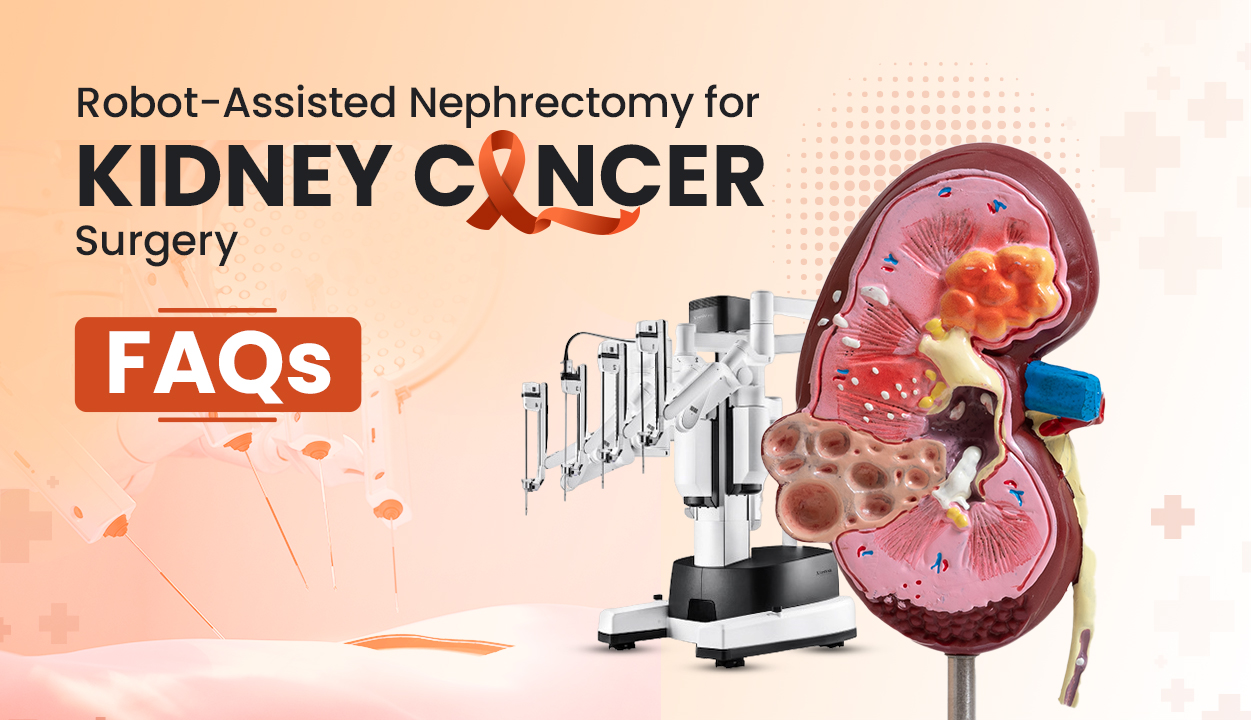
Robot-Assisted Nephrectomy for Kidney Cancer Surgery: FAQs
In recent years, technological advancements have revolutionized the field of surgery, offering minimally invasive surgery and more precise procedures. One such innovation is robot-assisted radical and partial nephrectomy, a surgical technique employed in the treatment of kidney cancer. This blog addresses frequently asked questions about robot-assisted partial and radical nephrectomy, shedding light on its benefits, risks, and critical considerations.
Q. What is Robot-Assisted Nephrectomy?
A. Robot-assisted nephrectomy is a minimally invasive surgery performed using robotic technology. It involves the removal of a cancerous or diseased kidney with the assistance of a robotic system controlled by a skilled surgeon. The Da Vinci Surgical System is a commonly used robotic platform for this procedure.
Q. What Types of Kidney Cancer Can Be Treated with Robotic Nephrectomy?
A. Robotic nephrectomy can be used to treat other types of kidney cancer, such as renal cell carcinoma (RCC), transitional cell carcinoma (TCC), and Wilms’ tumor (commonly found in children).
Q. How Does Robot-Assisted Nephrectomy Differ from Traditional Surgery?
A. Unlike traditional open surgery, robot-assisted nephrectomy is a minimally invasive surgery approach. Instead of a large incision, surgeons make a few small keyhole incisions to insert the robotic instruments and a camera. The surgeon takes control of the robotic arms from a robotic system console, allowing for enhanced precision within the confined space of the body.
Q. Who is an Ideal Candidate for Robot-Assisted Nephrectomy?
A. Robot-assisted nephrectomy is suitable for patients diagnosed with localized kidney cancer or other conditions requiring the removal of a kidney. However, not all patients may be eligible, and factors such as overall health, tumor size, and location influence the decision.
Q. Can Robotic Nephrectomy Be Performed on Both Partial and Radical Nephrectomy Cases?
A. Yes, robotic nephrectomy can be utilized for both partial nephrectomy (removal of a portion of the kidney) and radical nephrectomy (complete kidney removal). The choice between these approaches depends on tumor size, location, and overall kidney function.
Q. How is Robotic technology helpful in kidney cancer patients?
A. Robotic technology offers a precise & minimally invasive approach to surgeons to offer partial nephrectomy in some early-stage cancers, which can help save healthy kidneys to stay back in the patient compared to removing a complete kidney in a Radical nephrectomy.
Check with your surgeon if you are a candidate for Robotic partial nephrectomy.
Q. Why is saving kidneys important in kidney cancer patients?
A. Kidneys help in removing waste materials from the body. Saving healthy kidney tissue can prevent long-term dialysis rates & cardiovascular complications in patients. The state-of-the-art surgery, the gold standard, is nephron-sparing, preserving renal function in selected patients.
Q. What Are the Risks Associated with Robot-Assisted Nephrectomy?
A. While considered safe, like any surgical procedure, robot-assisted partial or radical nephrectomy carries some risks. Potential complications include infection, bleeding, injury to surrounding organs, and anesthesia-related issues. Discussing these risks with their surgeon expert before undergoing the procedure is essential.
Q. Will I Experience Pain During or After the Robotic Nephrectomy?
A. During the procedure, you will be under general anesthesia, ensuring that you do not experience any pain or discomfort. After the surgery, some mild to moderate pain or discomfort at the incision sites is normal and managed effectively with pain medications prescribed by your doctor.
Q. How Long Does the Recovery Take?
A. Recovery time varies, but one of the critical advantages of robot-assisted radical and partial nephrectomy is the quicker recovery compared to traditional open surgery. Most patients can start normal activities within a few weeks, with minimal postoperative pain.
Q. Are There Any Dietary or Lifestyle Restrictions or Changes I Need to Follow After Robotic Nephrectomy?
A. Your doctor will recommend dietary or lifestyle changes to support your recovery and overall health. These recommendations include staying hydrated and consuming a balanced diet of fruits and vegetables. Also, they need to avoid tobacco and excessive alcohol consumption and maintain a healthy weight.
Q. Are There Any Long-term Side Effects or Complications in Robotic Nephrectomy?
A. While robotic nephrectomy is generally safe, there can be potential long-term side effects or complications, such as changes in kidney function, hernia formation at the incision sites, or the development of secondary cancers. Your doctor will discuss these risks before the procedure and monitor you closely during follow-up appointments.
Robot-assisted radical and partial nephrectomy represents a significant advancement in kidney cancer surgery, offering patients a less invasive and more precise option. As with any medical procedure, individuals considering this surgery should consult with their healthcare team to determine its suitability for their specific case. For more guidance, you can book an appointment with our doctor. Click here: http://182.79.136.75:62/ to schedule your appointment.
